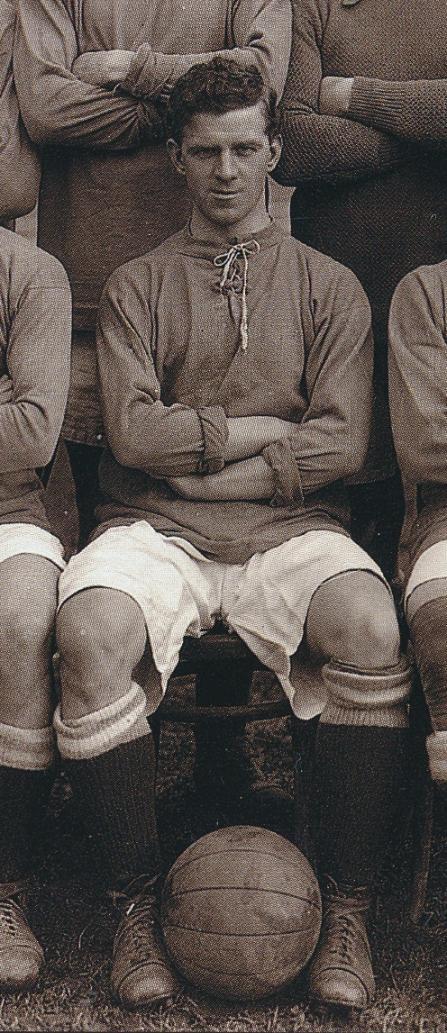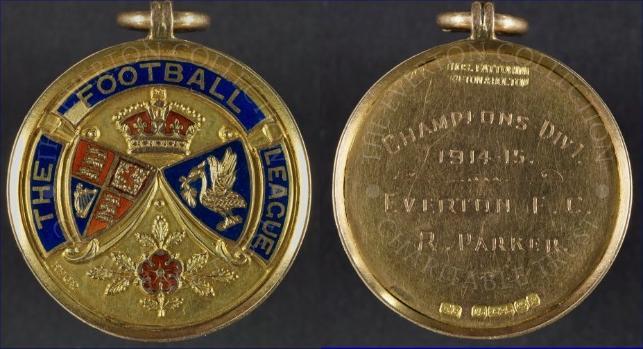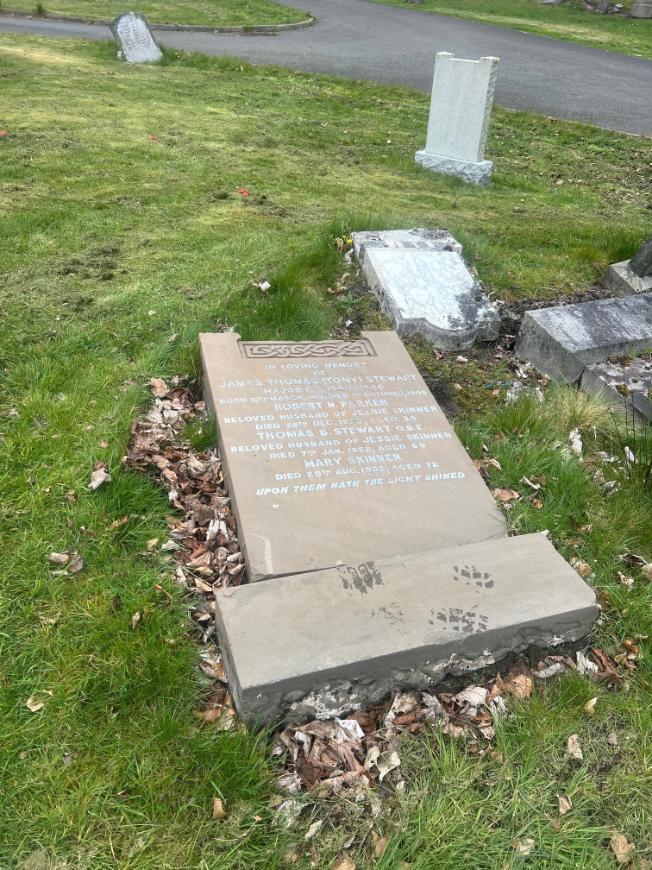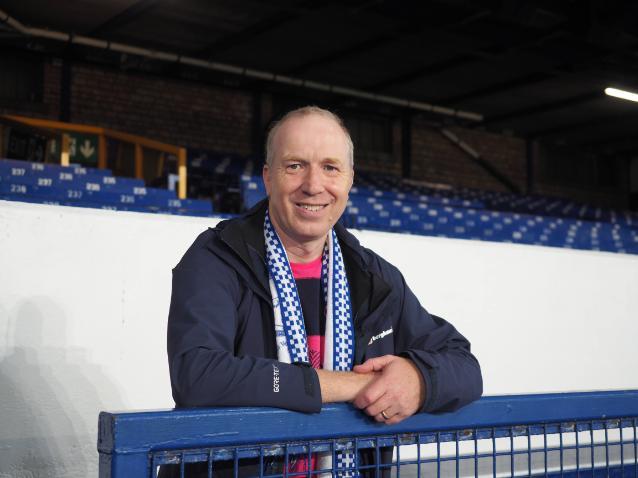The Bobby Parker Grave Restoration Appeal
01/07/2025 - 10.49
Rob Sawyer
Every November, Everton FC Heritage Society organises an event by the Dixie Dean statue at Goodison Park to commemorate those who made sacrifices during periods of conflict. Supported by Everton FC and other local bodies, it, understandably, focuses on those linked to the club who lost their lives while serving their country. However, there are many others who suffered, physically and/or mentally when serving their country, one of whom, Bobby Parker, seemed destined to become one of the football club’s all-time great centre-forwards.
Parker hailed from Possilpark, northern Glasgow and made his name in Scottish Junior football with Ashfield FC, earning a move to Rangers in 1910. Although his goal return for the Ibrox giants was fair, he found himself playing a secondary role to their great centre-forward Willie Reid.

Bobby Parker. Source: Everton Heritage Society
Everton moved in, in November 1913, determined to get the man they felt would liven up the attack which had lacked goal power since the premature sale of Bertie Freeman. Bobby took time to adjust to English football but, come the 1914/15 season, was in the scoring groove. Not only was he a superlative finisher - deadly from long range and great at driving through on goal - he was adept at coming deep and feeding his wingers. He had scored five hat-tricks on the way to 35 league goals - just shy of Freeman’s record of 37, but enough to get the Toffees over the line (just ahead of Oldham Athletic) to claim their second Football League crown and their first of the 20th Century. Of course, that season was overshadowed by unfolding geopolitical events, with many questioning if professional sports should be played at all in a time of war.

Bobby Parker's 1914-15 League Winner's Medal. Source: Everton Heritage Society
At just 24, there would normally have been every reason to believe that Bobby would go on to even greater footballing feats, but regular league and cup competitions were summarily suspended in the spring of 1915 and Bobby worked in a munitions factory in his home city, turning out for Greenock Morton as a guest. In April 1916, he had the terrible news that his brother, David, had died in a field hospital having been mortally wounded in action in the Somme region.
Perhaps as a tribute to his late brother, Bobby enlisted with the Royal Scots Fusiliers in the autumn of 1916 and was posted to the Middle East in the early spring of 1917. He would be facing Turkish forces backed by the German military machine. Within weeks of his arrival there, he suffered multiple shrapnel wounds (most likely eight) - possibly in the 2nd Battle of Gaza (research is ongoing to try to pinpoint this) and spent several months confined to bed in a military hospital in Egypt following surgery. The fog of war has made it hard to establish all the facts, with newspaper reports prone to underplay the exact nature and severity of injuries. Merseyside sports journalists often had to rely on letters sent to the Everton club secretary by players on active service for their updates. What is certain is that his recuperation was a long one and he was not fit to resume active duties before the armistice was signed in November 1918. It did mean that he did not transfer to the Western Front with his comrades - a blessing in disguise.
Discharged in September 1919, Bobby tried to pick up where he had left off at Everton. However, the magic was gone - whether that was due to the lasting impact of his war wounds or four years without high level football it is hard to say - a combination of factors seems most likely. He moved on to Nottingham Forest in 1921, helping them to promotion to the top flight before ending his playing days with Fraserburgh. Having dipped his toe in coaching with the Highland League side, he moved to Dublin in 1926, to become coach of Bohemians FC. His impact was dramatic, the Dalymount side claiming a unique domestic quadruple in the 1927/28 season.
Sadly, he was experiencing poor health by the early 1930s, which brought his coaching days to a premature end. It has often been suggested this was a direct result of ensuring war wounds - with the mythical ‘bullet lodged in his back’ one such story. There may well have been lingering impacts of his shrapnel wounds - maybe one or two fragments had not been successfully removed back in 1917. However, recent research points to him actually living with the advancement of multiple sclerosis. This is a chronic and often disabling disease in which the immune system mistakenly attacks the protective covering of nerve fibres in the central nervous system. Symptoms vary but may include vision problems, numbness, tingling, weakness, fatigue, balance and coordination issues, and cognitive problems. Bobby, who was receiving electric therapy treatment in 1933, would eventually be confined to a wheelchair. Unable to work and in poor financial, as well as physical, health, in 1937, he was granted an ongoing ‘pension’ by Everton FC - a noble deed done by his former employers, with no fanfare. To date, only Dixie Dean, and the aforementioned Bertie Freeman have scored more league goals in a season for Everton than Bobby.
Robert Norris Parker, Scottish league champion with Rangers, Football League champion at Everton, promotion winner with Nottingham Forest and multiple trophy winner with Bohemians passed away in December 1950 and was laid to rest in Lambhill Cemetery in Glasgow.
Over the years, the grave Bobby shares with other family members has fallen into disrepair and the headstone lies flat. Everton FC Heritage Society, inspired by member Tony Onslow, has set out to repair and re-erect the headstone and have it accompanied by a new, smaller monument which will list his sporting achievements and military service.

Bobby Parker's Family Grave and Headstone. Source: Everton Heritage Society
The overall cost is believed to be in the region of £2,500. The Society is seeking contributions to this project through a GoFundMe campaign, with a target of £1,500. Donations, no matter how modest, would be gratefully received. Click here for more information and to donate: https://gofund.me/5c2f5dd9
Bobby and his wife Jeanie did not have children but we do have contact with the grandchildren of one of his sisters. We would love to reach more family members, so any reading this are asked to message us via rsefc1878@gmail.com
For more on Bobby Parker, visit the Everton FC Heritage Society website:
https://efcheritagesociety.com/bobby-parker-1891-1950/
Biography
Rob Sawyer is a fourth generation Evertonian, whose great-grandfather, Bill Sawyer, served the Toffees as club secretary and director. A member of Everton FC Heritage Society since 2013, he is a regular contributor of historical articles to the Society's website and heritage page in the Blues' matchday programme. He also writes for Toffeeweb and has penned biographies of key figures at Goodison Park, including Harry Catterick and T.G. Jones. His most recent book, Broken Dreams (the first as a member of the Toffeeopolis publishing collective), focuses on the impact of the Second World War on the great School of Science team of 1938/39. Rob can be followed on Twitter/X at: @robsawyer70.


/prod01/wlvacuk/media/departments/digital-content-and-communications/submitted-news-images/Smelting-knife.png)
/prod01/wlvacuk/media/departments/digital-content-and-communications/images-2024/250630-SciFest-1-group-photo-resized-800x450.png)
/prod01/wlvacuk/media/departments/digital-content-and-communications/submitted-news-images/Way-youth-zone-August.JPG)
/prod01/wlvacuk/media/departments/digital-content-and-communications/images-2024/Arthi-Arunasalam-teaser.jpg)
/prod01/wlvacuk/media/departments/digital-content-and-communications/submitted-news-images/Muslim-woman-playing-football.jpg)
/prod01/wlvacuk/media/departments/digital-content-and-communications/submitted-news-images/Business-School-800x450.jpg)
/prod01/wlvacuk/media/departments/digital-content-and-communications/submitted-news-images/University-of-the-Year.jpg)
